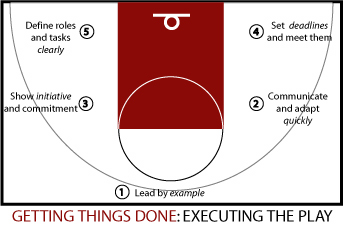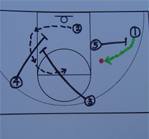Process Improvement Toolbox
- How to Perform a Walk-through
- How to Use the Nominal Group Technique
- Rapid-cycle testing: How to Conduct a Plan-Do-Study-ACT (PDSA) Cycle
- How to Flowchart
- How to Tell a Story
- How to Collect Data
- How to Establish a Change Team
- Visual Modeling Tools
- Creativity and Design
- Sustainability Model
- Getting Things Done
- Essential Team Behaviors
- Using Metaphors to Explore Continuous Improvement
- The Improvement Cafe
- Health Reform Readiness Index
- Technical Assistance Reports
- Recursos en Español
Getting Things Done

Many process improvement projects drag on for months with no clear direction or outcome, wasting organizational resources and damaging group morale. They fail not because of lack of innovation or managerial support, but because of poor execution.
The world of sports can teach us a lot about how to translate ideas into action. In basketball, for example, athletes and teams spend countless hours practicing and conditioning themselves to execute the right plays at the right time to win games. Basketball offers a powerful analogy on how to get things done.
What happens both off the court—during timeouts and half time breaks—and on the court influence how well a team executes during a given game. Meetings and planning sessions are the off-court activities that need to be productive in order for a change team's "on-court" performance to be well executed.
Use the Playbook: Define Roles and Tasks Clearly
|
Well-executed plays require players who know their roles and carry out their tasks in a clear, well-defined manner. Whether dribbling, passing, screening teammates, positioning for a rebound, or shooting the ball, everyone moves with a purpose. This is the value of having a proverbial playbook in any process improvement effort. It should provide the detailed actionable items and measurable outcomes of any change initiative. Matching the right people with the right tasks is of critical importance: if people do not have the appropriate skills, knowledge, or courage to do what is asked of them, the team will flounder. Each member of a team should know exactly what their role is, as well as the tasks that they need to perform—even if they are just "sitting on the bench." At some point, they can— and should—be involved in getting things done. |
The 24-Second Shot-Clock: Set Deadlines and Meet Them
|
Each time a team has the ball, they have exactly 24 seconds to attempt a valid shot. Unless players are oblivious to this "shot clock," they will at least try to make a shot, even if they miss the rim of the basket altogether. Rapid-cycle testing is the equivalent of the metaphorical "shot clock": it guards against not getting anything done. One of the most common pitfalls of change teams is the failure to set deadlines, or having a "rolling" deadline. Innovative change becomes diluted or does not materialize at all, which is why some change projects remain "in progress" a year after they began. |
Meetings: who does what by when
One concrete yardstick for successful process improvement initiatives is that every change team member should have a good sense of who does what by when in any change initiative. Use meetings efficiently to define roles and tasks and establish firm deadlines. Avoid creating subcommittees, which consume additional time and resources.
Moving Without the Ball: Initiative and Commitment
|
One of the fundamental skills in a "motion offense" is effective player movement without the ball. Since most players don't have the ball 70-80 percent of the time, that means getting free to make a shot, helping a teammate get free, creating mismatches in the defense, or positioning for a rebound. A player who just stands around is useless, and in many ways is a liability to the team. In change teams, team members frequently wait for their colleagues to finish certain tasks. That way, they don't have to begin doing their tasks earlier than they should, and if things are running late, they don't necessarily take the blame. By showing commitment and initiative, however—helping team members complete a task, meeting deadlines earlier, or taking on additional tasks beyond expectations—teams can get things done faster, and perhaps better. Initiative and commitment can be infectious, which is why some change teams seem to do phenomenal, productive work. |
The Nature of the Game: Communicate and Adapt Quickly
|
Any play, no matter how complex and innovative, does not ever go smoothly when executed. Because a game is fluid and dynamic, subject to a thousand possible sources of variation, players communicate throughout the game — calling out plays, using hand and eye signals, reading each other's body movements — and adapt their strategy in response. And because there's a time element, it is important to respond quickly, or the opponent — in the organization's case, the status quo — gets the ball. Change teams need to establish a transparent and efficient channel of communication— whether through old-fashioned meetings and memos, or phone, e-mail, instant messaging, internal weblogs, and other modes of communication. The denser the communication network is— the more direct connections that exist between individuals—the faster messages travel, and the less likely they are to be misinterpreted. Change teams should also learn to be agile enough to have impromptu meetings—like the quick 20-second timeouts that happen during real basketball games—to assess project status and perhaps change strategies. |
The Playmaker: Lead by Example
|
A team's point guard arguably has the most difficult job, because he/she has to assess players' health and morale, orchestrate the appropriate plays, test the opponent's weak spots, and if necessary, take the shot himself/herself. Good playmakers know their teammates' strengths and weaknesses, help them expand their abilities, raise their confidence, and put them in positions where they can contribute the most. They are detail-oriented and have an intimate knowledge of the playbook. They trust their teammates, are decisive on tough game situations, and always follow through. A change leader's job is no different. The team's energy, motivation, and productivity correlate directly with the leader's. Whatever behaviors leaders exhibit, promote, or tolerate, so too will his/her teammates. |
Leadership, structure, and emergence
Effective execution requires a well-defined play and an astute playmaker, as well as fluid movement and communication during game time. In our organizations, this translates to good leadership and an efficient structure , which enables positive behavior—and outcomes—down the road. Theorists talk about the property of " emergence"—a combination of interactions bringing surprising results that exceed expectations—when the whole becomes greater than the sum of its parts.








